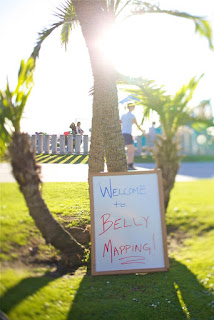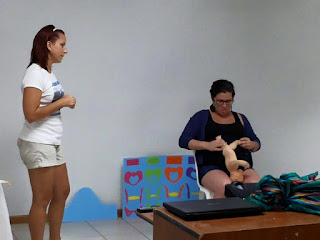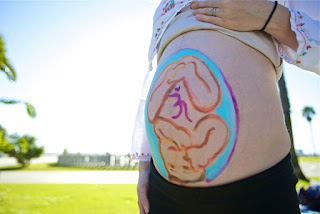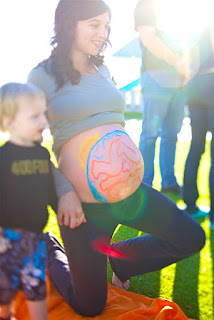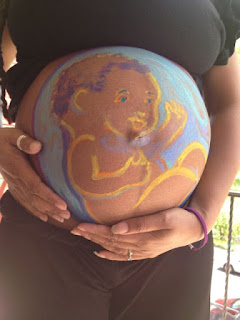Belly Mapping

Gail Tully is the developer and creator of Belly Mapping. Belly Mapping is a 3-step process to estimate your baby’s position in the womb. Many pregnant people can estimate with fairly good accuracy in their last trimester of pregnancy.
Step 1. Feel the contours of your baby with the pads of your fingers.
Draw a circle adding four parts to help you draw baby’s small parts in location. Fill in the “pie” you’ve drawn with marks to indicate the kicks, flutters, bulges and firm, smooth areas.
Put a doll over your map and then over your belly to visualize your baby’s actual position. Do the hands match the location of small flutters or are the doll’s hands going the other direction? Put the doll’s feet where you feel the biggest kicks and swing the dolls back around to match the largest firm, smooth part of the baby that you feel. (An anterior placenta will mask the baby with the big, smooth placenta.)
Step 2: Visualize baby using a doll. Holding a doll over your map and then your belly, put the doll’s head where you know or suspect your baby’s head to be. Place the doll’s back where you feel the smoothest flat, firm area. Remember, you find that area on your own back. You won’t likely be accurate if you try to locate baby while you stand up. Your stomach muscles will be engaged and hard to feel details through them.
In your lasts months of pregnancy your baby’s kicks and wiggles become more certain, more perceivable. When you lie on your back with your knees bent your abdomen is often soft enough to feel through your skin and uterine wall to contact your baby.
Feel your baby’s contours. The womb and your belly muscles, even though they are likely softer now, will protect your baby during your gentle but determined touch. Getting to know your baby’s shape will help you picture baby’s position in your womb.
| Visualizing baby by having a friend paint baby’s picture on your belly in the actual position of baby is a fun way to finish up! |
Let’s explore how bonding may increase. Your hand moves the pencil or crayon towards the curves and lines of your child. It’s as if you discover this mysterious
visitor as you draw. You see the image, you feel the love of creation as you draw. This is the being within and this is the art which expresses your hope, your wonder, your own emerging self.
 |
| If someone paints your belly, as Gail is about to do here, they will be more accurate if they feel your baby first. |
1.
Right, Left, Anterior, Posterior are the directional words for mother’s body. Baby’s body part words used are Occiput for a head down baby or Sacrum for a breech.

